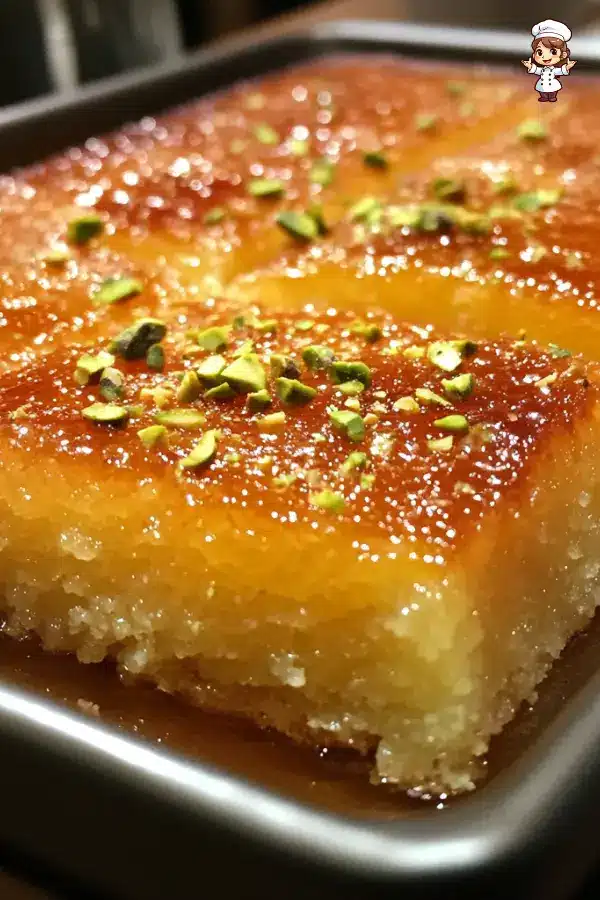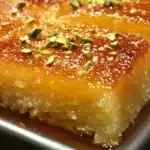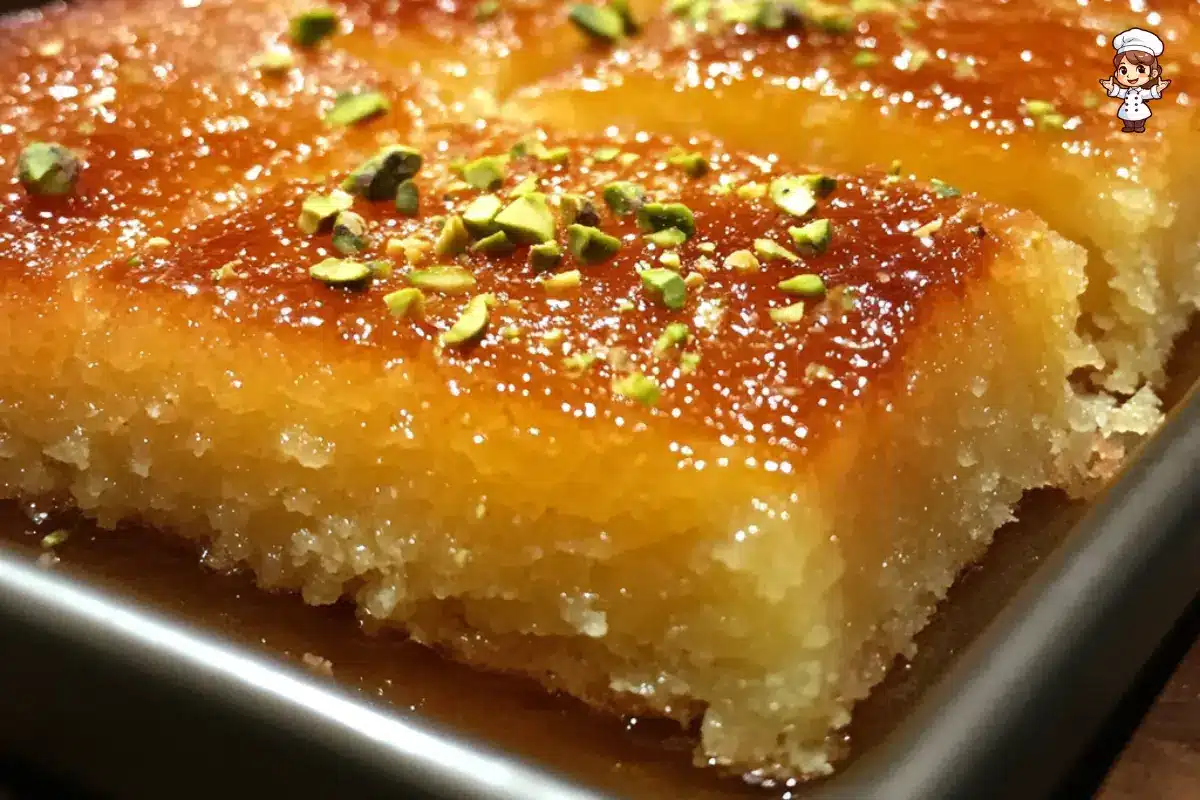Semolina cake, known for its light yet rich texture, is a beloved dessert in many cultures. Among its many variations, Turkish Revani stands out as a sweet, syrup-soaked delight that captures the essence of Turkish desserts. This cake is made from semolina, which gives it a slightly gritty but perfectly tender crumb, and is soaked in a sweet syrup, making every bite a combination of softness and sweetness. In this article, we’ll explore everything there is to know about making Semolina Cake, including the key ingredients, step-by-step instructions, variations, and serving tips. Whether you’re new to Turkish desserts or a seasoned baker, you’ll love this easy-to-follow guide.
Key Ingredients in Semolina Cake
Semolina: The Star Ingredient
The main ingredient that defines Semolina Cake is, of course, semolina. Made from durum wheat, semolina provides a slightly gritty texture that sets this cake apart from others. When baked, it creates a tender crumb that contrasts beautifully with the syrup soaking in. Semolina also adds a slightly nutty flavor that’s unique to this dessert, making every bite a bit richer and more satisfying. It’s no wonder semolina is a key player in both Turkish Revani and other regional desserts.
The Role of Yogurt and Oil
Yogurt and oil contribute to the semolina cake’s delightful moistness. The yogurt adds a slight tanginess and helps the cake stay tender, while the oil ensures the right amount of richness. If you’re wondering, the oil doesn’t overpower the flavor—instead, it complements the semolina, making the cake wonderfully soft without being greasy. These ingredients are essential for the cake’s texture, creating that melt-in-your-mouth experience.
Zest and Vanilla: Adding a Zing of Flavor
Lemon or orange zest is another key ingredient in Revani, adding a fresh citrus note to balance out the sweetness of the syrup. The zest’s natural oils infuse the batter with a light, refreshing fragrance, making each bite more aromatic. Similarly, a touch of vanilla extract adds warmth and depth, giving the semolina cake a well-rounded flavor profile. Together, these ingredients elevate the simple semolina base and take this dessert to another level.
Flour, Baking Powder, and Salt: The Structural Elements
Though semolina is the star, all-purpose flour plays a role in helping the cake rise and stay together. The baking powder helps the cake achieve that perfect fluffiness, ensuring it doesn’t end up too dense or heavy. A pinch of salt, often overlooked, is essential to balance the sweetness and highlight the flavors of the cake.
The Syrup: Sweetening the Cake
The syrup is what makes Turkish Revani truly magical. Made from sugar, water, and lemon juice, it adds sweetness and moisture to the cake. The key is to use warm syrup and pour it over the semolina cake while it’s still hot, allowing the cake to absorb it fully. For a floral twist, you can add a teaspoon of orange blossom or rosewater to the syrup. This infusion gives the cake an extra layer of fragrance, making each bite even more indulgent.
Step-by-Step Guide to Making Semolina Cake

Preparing the Cake Batter
To make the perfect semolina cake, start by preheating your oven to 175°C (350°F) and greasing a 20×20 cm (8×8 inch) baking dish. In a large mixing bowl, beat the eggs and sugar together until light and fluffy. This is an important step because it creates the airiness that the cake needs. Next, add the yogurt, sunflower oil, vanilla extract, and citrus zest. Mix until everything is well incorporated, creating a smooth, creamy batter.
In a separate bowl, whisk together the semolina, flour, baking powder, and salt. Slowly add the dry ingredients to the wet ingredients, mixing as you go. You should aim for a smooth batter, but don’t overmix—it’s fine if it’s a little lumpy. Once the batter is ready, pour it into the prepared baking dish and smooth the top to ensure even baking.
Baking the Cake
Now, it’s time to bake the semolina cake. Place the dish in the preheated oven and bake for 30-35 minutes, or until the cake turns a beautiful golden color. You can check for doneness by inserting a toothpick into the center; if it comes out clean, the cake is ready. The texture should be soft and fluffy, but not overly moist. Once it’s baked, remove the cake from the oven and set it aside while you prepare the syrup.
Preparing the Syrup
In a saucepan, combine 200g of sugar and 240ml of water. Bring the mixture to a boil, stirring occasionally to dissolve the sugar. Once the sugar is dissolved, lower the heat and let the syrup simmer for about 10 minutes. Add the juice of half a lemon and, if desired, a teaspoon of orange blossom or rosewater. Simmer for another 2 minutes to let the flavors combine, then remove from heat and let it cool slightly.
Soaking the Cake
Once the cake has finished baking and the syrup is ready, it’s time for the crucial step: soaking the cake. While the semolina cake is still hot, pour the warm syrup evenly over it. You may think it’s too much syrup, but don’t worry—the cake will soak it all up, becoming delightfully moist and flavorful. Allow the cake to absorb the syrup for about an hour before serving.
Now, your Turkish Revani is ready to be enjoyed! It can be served as is or garnished with a sprinkle of ground pistachios, shredded coconut, or more citrus zest for extra flavor and visual appeal.
Semolina Cake Variations and Customization Ideas
Classic Turkish Revani vs. Other Variations
While Turkish Revani is a beloved classic, there are many variations of the semolina cake that give you the freedom to play with flavors and ingredients. For instance, the traditional Revani is made with semolina, yogurt, and a simple syrup. However, you can easily tweak the recipe to suit different tastes.
One popular variation is adding citrus zest for a fresher, more vibrant flavor. Lemon or orange zest can be added to the batter to enhance the cake’s aroma and bring a refreshing twist. For those who love richer flavors, you can also add nuts such as pistachios or almonds to the cake or syrup. Not only will this give your semolina cake a nutty crunch, but it will also provide an extra layer of depth to the dessert.
Floral Notes for a Unique Flavor
Another variation of the semolina cake involves infusing the syrup with orange blossom water or rosewater. These floral waters add an exotic touch, transforming the cake into a fragrant treat that’s perfect for special occasions. If you want to give your Revani a Mediterranean or Middle Eastern flair, these ingredients will elevate your dessert and make it even more memorable.
These small adjustments can help you personalize your semolina cake, whether you prefer it zesty, nutty, or floral. Feel free to experiment with these variations to create your perfect version of this traditional treat.
Serving Suggestions and Pairings
Perfect Pairings for Semolina Cake
Turkish Revani is a versatile dessert that pairs wonderfully with a variety of beverages and sides. For a traditional experience, serve the semolina cake with a cup of Turkish coffee or strong black tea. The rich, bitter flavor of the coffee balances the sweet, syrupy cake perfectly, creating a delightful contrast that enhances the dessert’s flavors.
If you’re looking for something lighter, Revani also pairs well with a refreshing yogurt drink, also known as “Ayran” in Turkish cuisine. The creamy tanginess of Ayran complements the moistness of the cake, providing a balanced and satisfying dessert experience.
Garnishes and Presentation
The presentation of your semolina cake can also elevate the experience. Once soaked in syrup, you can garnish it with a sprinkle of finely chopped pistachios, shredded coconut, or a few fresh mint leaves. For added flair, you can dust the cake with a little extra citrus zest, or even drizzle some extra syrup on top.
Serving your semolina cake in small squares or diamond shapes is the traditional way, making it perfect for sharing at gatherings, celebrations, or casual get-togethers.
If you’re in the mood for more delicious recipes, check out our recipe article on Almond Nut Cake.
Health Considerations and Nutritional Information
Nutritional Breakdown of Semolina Cake
While Semolina Cake is undeniably a delicious treat, it’s always a good idea to know what’s in it. Each slice of Turkish Revani contains about 290 kcal, making it a relatively moderate dessert when enjoyed in reasonable portions. The cake itself is made from ingredients like semolina, sugar, and yogurt, which together provide a balance of carbohydrates, fats, and protein. The syrup, however, adds a significant amount of sugar, so it’s important to enjoy the cake in moderation.
Is Semolina Cake Healthy?
In terms of health benefits, semolina cake isn’t exactly a “health food,” but it does provide some nutritional value. Semolina, made from durum wheat, contains fiber, which can aid digestion. Additionally, yogurt in the recipe offers a good dose of calcium and protein. That said, if you’re looking to make a healthier version of Revani, consider reducing the sugar in the syrup or swapping out some of the oil for a healthier fat like olive oil. You can also experiment with low-fat yogurt to cut back on calories.
Troubleshooting Common Issues When Making Semolina Cake
The Cake is Too Dry
One of the most common problems with making Semolina Cake is ending up with a dry texture. If this happens, it’s often because the cake has been overbaked or the syrup hasn’t been absorbed properly. To prevent dryness, make sure you check the cake’s doneness with a toothpick—remove it from the oven when it comes out clean but not dry. Additionally, when pouring the syrup over the cake, make sure it is warm, not hot, and that you pour it evenly to allow the cake to soak it up completely.
The Cake is Too Wet
On the other hand, if your semolina cake becomes soggy, it may be due to an excess of syrup or not letting the cake cool slightly before serving. While the syrup should be generously applied, the cake shouldn’t be drowning in it. For better control, pour the syrup slowly and in stages, ensuring the cake absorbs it gradually. If the cake is too wet, it might have been soaked for too long, so next time, let it sit for only about 45 minutes to 1 hour to absorb the syrup.
Cake Not Rising
If your Revani doesn’t rise properly, the issue could be with the baking powder. Ensure that your baking powder is fresh and hasn’t expired. Also, avoid overmixing the batter after adding the dry ingredients. Stir gently to maintain the airiness needed for a fluffy texture.
For more delicious recipes, be sure to explore our article on Almond Nut Cake.
Frequently Asked Questions (FAQ)
Can I Use a Different Type of Oil in Semolina Cake?
Yes, you can! While the recipe calls for sunflower oil or any neutral oil, you can use other oils like vegetable oil or even olive oil for a different flavor. Keep in mind that olive oil might give your semolina cake a slightly more pronounced taste, but it still works well in the batter.
How Do I Store Leftover Semolina Cake?
To store leftover Turkish Revani, let it cool completely before covering it with plastic wrap or placing it in an airtight container. It can be kept at room temperature for about 2-3 days, or you can refrigerate it for up to a week. If refrigerated, you might want to warm it slightly before serving to bring out the best texture and flavor.
Can I Freeze Semolina Cake for Later?
Yes, semolina cake can be frozen for later enjoyment. To do so, let the cake cool completely, then wrap it tightly in plastic wrap or foil and place it in a freezer-safe container. It can be frozen for up to 3 months. When you’re ready to enjoy it, thaw the cake in the refrigerator overnight, and reheat it in the oven or microwave before serving.
What Can I Substitute for Semolina in This Cake?
If you don’t have semolina, you can substitute it with fine polenta or cornmeal, though the texture may differ slightly. Keep in mind that semolina provides a unique texture, so if you’re trying to replicate the authentic taste and feel of Revani, semolina is the best choice.
Print
Turkish Revani (Semolina Cake with Syrup)
- Total Time: 50 minutes (plus soaking)
- Yield: 9 slices 1x
- Diet: Halal
Description
Turkish Revani is a delicious semolina cake soaked in sweet syrup. This easy-to-make dessert is a perfect balance of moisture and flavor, making it a favorite in Turkish cuisine.
Ingredients
- 3 large eggs
- 150g (3/4 cup) granulated sugar
- 120ml (1/2 cup) plain yogurt
- 120ml (1/2 cup) sunflower oil or neutral oil
- 1 tsp vanilla extract
- Zest of 1 lemon or orange
- 200g (1 cup) fine semolina
- 60g (1/2 cup) all-purpose flour
- 1 tsp baking powder
- A pinch of salt
- 200g (1 cup) granulated sugar (for syrup)
- 240ml (1 cup) water (for syrup)
- Juice of half a lemon (for syrup)
- Optional: 1 tsp orange blossom water or rosewater (for syrup)
- Optional Garnish: Ground pistachios, shredded coconut, lemon or orange zest
Instructions
- Preheat your oven to 175°C (350°F). Grease a 20×20 cm (8×8 inch) baking dish.
- In a mixing bowl, beat the eggs and sugar until light and fluffy.
- Add the yogurt, oil, vanilla, and citrus zest. Mix until well combined.
- In a separate bowl, whisk together semolina, flour, baking powder, and salt.
- Gradually add the dry ingredients to the wet ingredients. Mix until smooth.
- Pour the batter into the prepared baking dish and smooth the top.
- Bake for 30-35 minutes or until golden and a toothpick comes out clean.
- While the cake bakes, prepare the syrup: In a saucepan, combine sugar and water. Bring to a boil, then lower heat and simmer for 10 minutes.
- Add lemon juice and optional orange blossom/rosewater. Simmer for 2 more minutes, then remove from heat. Let it cool slightly.
- Once the cake is baked, remove from the oven and immediately pour the warm syrup evenly over the hot cake.
- Let the cake absorb the syrup completely—this may take up to 1 hour.
- Garnish as desired and cut into squares or diamonds to serve.
Latest Amazon Finds
Notes
- Ensure the syrup is warm, not hot, when pouring over the cake for best absorption.
- You can add nuts like pistachios or almonds for extra texture and flavor.
- If the cake is too dry, it could be overbaked, so check it regularly while baking.
- Prep Time: 15 minutes
- Cook Time: 35 minutes
- Category: Dessert
- Method: Baking
- Cuisine: Turkish
Nutrition
- Serving Size: 1 slice
- Calories: 290 kcal
- Sugar: 28g
- Sodium: 15mg
- Fat: 12g
- Saturated Fat: 1g
- Unsaturated Fat: 10g
- Trans Fat: 0g
- Carbohydrates: 44g
- Fiber: 2g
- Protein: 4g
- Cholesterol: 35mg
Keywords: Semolina Cake, Turkish Revani, Basbousa, syrup soaked cake, semolina dessert








